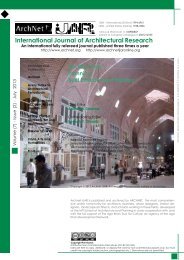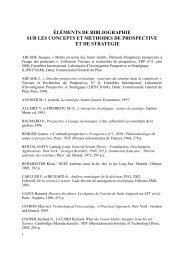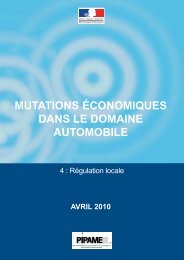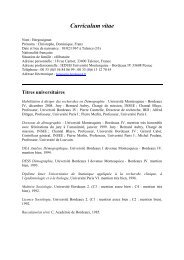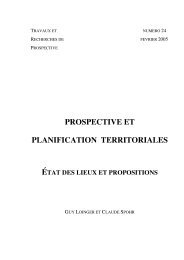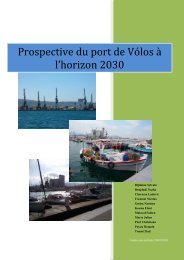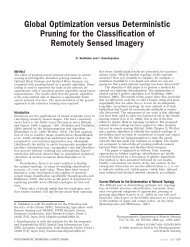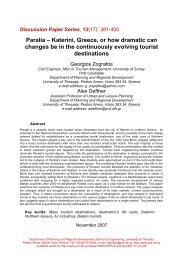The heterogeneity of the Population in Greece (A spatial approach)
The heterogeneity of the Population in Greece (A spatial approach)
The heterogeneity of the Population in Greece (A spatial approach)
You also want an ePaper? Increase the reach of your titles
YUMPU automatically turns print PDFs into web optimized ePapers that Google loves.
<strong>The</strong> <strong>heterogeneity</strong> <strong>of</strong> <strong>the</strong> <strong>Population</strong> <strong>in</strong> <strong>Greece</strong><br />
(A <strong>spatial</strong> <strong>approach</strong>)<br />
Byron Kotzamanis [1], Anastasia Kostaki [2] ,<br />
[1] Laboratory <strong>of</strong> Demographic and Social Analyses, Department <strong>of</strong> Plann<strong>in</strong>g and<br />
Regional Development, University <strong>of</strong> <strong>The</strong>ssaly, <strong>Greece</strong><br />
email: bkotz@prd.uth.gr<br />
[2] Department <strong>of</strong> Statistics, A<strong>the</strong>ns University <strong>of</strong> Economics and Bus<strong>in</strong>ess, <strong>Greece</strong> ,<br />
email: kostaki@aueb.gr<br />
Laboratory <strong>of</strong> Demographic and Social Analyses<br />
6 th International Conference on <strong>Population</strong> Geographies<br />
Umeå, 14-17 June 2011<br />
1
Backround<br />
‣Τhe<br />
<strong>in</strong>tense flows <strong>of</strong> <strong>in</strong>ternal migration dur<strong>in</strong>g <strong>the</strong> post war years <strong>in</strong> <strong>Greece</strong>, comb<strong>in</strong>ed<br />
with<br />
‣selective<br />
emigration and repatriation <strong>of</strong> Grεeks<br />
liv<strong>in</strong>g abroad,<br />
and<br />
‣<strong>the</strong> massive entry <strong>of</strong> foreigners s<strong>in</strong>ce 1990,<br />
have radically transformed <strong>the</strong> post war population map <strong>of</strong> <strong>the</strong> country.<br />
<strong>The</strong>se three phenomena led to a rapid urbanization and a substantial <strong>in</strong>crease <strong>of</strong> <strong>the</strong><br />
population <strong>heterogeneity</strong>. <strong>The</strong> first <strong>of</strong> <strong>the</strong>se consequences (urbanisation(<br />
urbanisation) ) monopolized<br />
<strong>the</strong> <strong>in</strong>terest and has received numerous research works <strong>in</strong> <strong>the</strong> last t decades. In contrast,<br />
<strong>the</strong> second effect is much less studied.<br />
Laboratory <strong>of</strong> Demographic and Social Analyses<br />
2
Aim <strong>of</strong> <strong>the</strong> work<br />
<strong>The</strong> aim <strong>of</strong> this work is, us<strong>in</strong>g data <strong>of</strong> <strong>the</strong> last census (2001) to attempt an assessment<br />
<strong>of</strong> <strong>the</strong> <strong>heterogeneity</strong> <strong>of</strong> <strong>the</strong> population <strong>in</strong> <strong>Greece</strong> at <strong>the</strong> lowest possible <strong>spatial</strong><br />
level (municipality) and to highlight <strong>the</strong> <strong>spatial</strong> patterns <strong>of</strong> comb<strong>in</strong><strong>in</strong>g <strong>the</strong> "game"<br />
<strong>of</strong> <strong>the</strong> three variables:<br />
‣ <strong>in</strong>ternal migration,<br />
‣ repatriation <strong>of</strong> Greeks liv<strong>in</strong>g abroad<br />
(economic emigrants, political refugees, co-ethnics)<br />
‣ and immigration.<br />
Laboratory <strong>of</strong> Demographic and Social Analyses<br />
3
Data<br />
<strong>Population</strong> data for <strong>the</strong> 1034 municipalities <strong>of</strong> <strong>Greece</strong> from <strong>the</strong> 2001 census.<br />
<strong>The</strong> data concern a total <strong>of</strong> 10,934 million residents, where<br />
762.000 people were foreigners<br />
10,172 million were Greek<br />
(7% <strong>of</strong> <strong>the</strong> total population) and<br />
Greek citizens (93%).<br />
From those hav<strong>in</strong>g Greek citizenship:<br />
446.000 were born abroad (4.6% <strong>of</strong> Greeks and 4.3% <strong>of</strong> total population) and<br />
9,705 million were born <strong>in</strong> <strong>Greece</strong> (95,4% <strong>of</strong> Greeks and 88,8% <strong>of</strong> total population).<br />
40% <strong>of</strong> <strong>the</strong>m<br />
<strong>the</strong>m (3,878 million) at<br />
Among Greek citizens born <strong>in</strong> <strong>Greece</strong>:<br />
at 2001 were liv<strong>in</strong>g <strong>in</strong> ano<strong>the</strong>r municipality than that <strong>of</strong><br />
birth.<br />
Laboratory <strong>of</strong> Demographic and Social Analyses<br />
4
In order to highlight <strong>the</strong> various <strong>spatial</strong> patterns,<br />
<strong>the</strong> municipalities are classified<br />
us<strong>in</strong>g <strong>the</strong> follow<strong>in</strong>g three classification criteria<br />
‣ <strong>the</strong> % <strong>of</strong> foreigners <strong>in</strong> <strong>the</strong> total population <strong>of</strong> <strong>the</strong> municipality<br />
‣ <strong>the</strong> % <strong>of</strong> Greeks born abroad to <strong>the</strong> total population <strong>of</strong> Greeks <strong>in</strong> <strong>the</strong><br />
municipality<br />
‣ <strong>the</strong> % <strong>of</strong> Greeks residents, born <strong>in</strong> ano<strong>the</strong>r municipality to <strong>the</strong> total<br />
population <strong>of</strong> Greeks <strong>in</strong> <strong>the</strong> municipality<br />
Laboratory <strong>of</strong> Demographic and Social Analyses<br />
5
Statistical Methodology<br />
In order to reveal <strong>the</strong> optimal group<strong>in</strong>g <strong>of</strong> <strong>the</strong> municipalities <strong>in</strong>to homogenous<br />
groups, accord<strong>in</strong>g to <strong>the</strong> three criteria considered, we use <strong>the</strong> procedure <strong>of</strong><br />
Two-step Cluster Analysis,<br />
<strong>The</strong> analysis is implemented <strong>in</strong> <strong>the</strong> SPSS statistical package<br />
Laboratory <strong>of</strong> Demographic and Social Analyses<br />
6
Results<br />
Classification <strong>of</strong> <strong>the</strong> municipalities accord<strong>in</strong>g to <strong>the</strong> % <strong>of</strong> foreigners<br />
<strong>in</strong> <strong>the</strong>ir total population<br />
Laboratory <strong>of</strong> Demographic and Social Analyses<br />
7
Map 1: Classification <strong>of</strong> <strong>the</strong> municipalities accord<strong>in</strong>g<br />
<strong>the</strong> % <strong>of</strong> foreigners <strong>in</strong> <strong>the</strong>ir total population<br />
Figure 1: 95% confidence <strong>in</strong>tervals for <strong>the</strong> means <strong>of</strong> <strong>the</strong> percentages <strong>of</strong><br />
foreigners to <strong>the</strong> total population <strong>in</strong> <strong>the</strong> municipality.<br />
0,25<br />
Table 1: Classification <strong>of</strong> municipalities accord<strong>in</strong>g <strong>the</strong> proportion <strong>of</strong> foreign population<br />
Cluster<br />
% <strong>of</strong><br />
foreigners<br />
<strong>in</strong> <strong>the</strong> municipalities<br />
Number <strong>of</strong><br />
municipaliti<br />
es<br />
Cumulative number<br />
<strong>of</strong><br />
municipaliti<br />
es<br />
Total population<br />
0,20<br />
0,15<br />
0,10<br />
0,05<br />
0,00<br />
1<br />
Cumulative<br />
Total population<br />
2<br />
Cluster<br />
Reference L<strong>in</strong>e is <strong>the</strong> Overall Mean = ,06<br />
Number<br />
<strong>of</strong> foreigners<br />
3<br />
Cumulative<br />
number<br />
<strong>of</strong> foreigners<br />
1 16,7 - 43,9 36 36 966982 966982 171514 171514<br />
2 10,0 - 16,6 131 167 814827 1781809 100486 272000<br />
3 4,8 - 9,9 359 526 5597890 7379699 385897 657897<br />
4 0,0 - 4,7 508 1034 3554398 10934097 103916 761813<br />
Total 1034 10934097 761813<br />
Cluster<br />
% <strong>of</strong><br />
foreigners<br />
<strong>in</strong> <strong>the</strong> municipalities<br />
Percentages <strong>of</strong><br />
municipalities<br />
Cumulative<br />
percentages <strong>of</strong><br />
municipalities<br />
Percentages <strong>of</strong><br />
population<br />
Cumulative<br />
percentages<br />
<strong>of</strong> population<br />
Laboratory <strong>of</strong> Demographic and Social Analyses<br />
Percentage <strong>of</strong><br />
foreigners<br />
Cumulative<br />
percentage <strong>of</strong><br />
foreigners<br />
4<br />
1 16,7 - 43,9 3,48 3,48 8,84 8,84 22,51 22,51<br />
2 10,0 - 16,6 12,67 16,15 7,45 16,30 13,19 35,70<br />
3 4,8 - 9,9 34,72 50,87 51,20 67,49 50,66 86,36<br />
4 0,0 - 4,7 49,13 100,00 32,51 100,00 13,64 100,00<br />
Total 100,00 100,00 100,00<br />
8
Map 1: Classification <strong>of</strong> <strong>the</strong> municipalities accord<strong>in</strong>g <strong>the</strong> % <strong>of</strong> foreigners <strong>in</strong> <strong>the</strong>ir total population<br />
Laboratory <strong>of</strong> Demographic and Social Analyses<br />
Map 1 reflects <strong>the</strong> differential distribution <strong>of</strong> foreigners <strong>in</strong><br />
<strong>Greece</strong>.<br />
In almost half <strong>of</strong> municipalities (compris<strong>in</strong>g only 1 / 3 <strong>of</strong><br />
<strong>the</strong> total population, Cluster 4) <strong>the</strong> % <strong>of</strong> foreigners are<br />
extremely low and well below <strong>the</strong> national average (7%).<br />
<strong>The</strong>se municipalities, generally hav<strong>in</strong>g small or medium<br />
sized population conta<strong>in</strong><strong>in</strong>g only 13% <strong>of</strong> <strong>the</strong> foreigners,<br />
while occupy<strong>in</strong>g <strong>the</strong> greater part <strong>of</strong> <strong>the</strong> country. <strong>The</strong>se are<br />
laced at most <strong>in</strong> mounta<strong>in</strong>ous and semi-mounta<strong>in</strong>ous areas.<br />
In contrast, <strong>in</strong> two o<strong>the</strong>r groups <strong>of</strong> municipalities<br />
(Clusters 1 and 2) <strong>the</strong> % <strong>of</strong> foreigners are well above <strong>the</strong><br />
national average (greater than 10%). <strong>The</strong>se municipalities<br />
conta<strong>in</strong> 1/4 <strong>of</strong> <strong>the</strong> total population but 36% <strong>of</strong> all<br />
foreigners. <strong>The</strong>se are located <strong>in</strong> <strong>the</strong> most economically<br />
developed areas <strong>of</strong> <strong>the</strong> country, i.e. <strong>in</strong> <strong>the</strong> major urban<br />
centres <strong>of</strong> cont<strong>in</strong>ental <strong>Greece</strong>, <strong>in</strong> <strong>the</strong> coastal zone <strong>of</strong><br />
Peloponnesus, and islands, which are agricultural and/or<br />
touristy developed, as well as <strong>in</strong> areas neighbour<strong>in</strong>g<br />
Albania.<br />
9
Results<br />
Classification <strong>of</strong> <strong>the</strong> municipalities accord<strong>in</strong>g <strong>the</strong> % <strong>of</strong> Greeks born abroad<br />
Laboratory <strong>of</strong> Demographic and Social Analyses<br />
10
Map 2: Classification <strong>of</strong> <strong>the</strong> municipalities accord<strong>in</strong>g <strong>the</strong> % <strong>of</strong> Greeks born abroad<br />
Figure 2: 95% confidence <strong>in</strong>tervals for <strong>the</strong> means <strong>of</strong> <strong>the</strong> percentages <strong>of</strong><br />
Greeks not born <strong>in</strong> <strong>Greece</strong> to <strong>the</strong> total Greek population <strong>in</strong> <strong>the</strong> municipality.<br />
0,40<br />
0,30<br />
Table 2: Classification <strong>of</strong> municipalities accord<strong>in</strong>g <strong>the</strong> percentages <strong>of</strong> Greeks not born <strong>in</strong> <strong>Greece</strong> to <strong>the</strong> total Greek population <strong>in</strong> <strong>the</strong> municipality<br />
Cluster<br />
% <strong>of</strong> Greeks not<br />
born <strong>in</strong> <strong>Greece</strong> to<br />
<strong>the</strong> total Greek<br />
population<br />
<strong>in</strong> <strong>the</strong> municipality<br />
Number<br />
<strong>of</strong> municipalities<br />
Cumulative number<br />
<strong>of</strong> municipalities<br />
Total population<br />
Cumulative<br />
total population<br />
Number<br />
<strong>of</strong><br />
Greeks not<br />
born <strong>in</strong> <strong>Greece</strong><br />
1 14,8 - 50,0 11 11 154465 154465 30892 30892<br />
Cumulativ<br />
e number<br />
<strong>of</strong> Greek<br />
not born<br />
<strong>in</strong> <strong>Greece</strong><br />
2 7,3 - 13,2 73 84 1690247 1844712 166152 197044<br />
3 2,9 - 7,2 252 336 4405730 6250442 206958 404002<br />
4 0,0 - 2,8 698 1034 3921842 10172284 62612 466614<br />
Total 1034 10172284 466614<br />
Cluster<br />
% <strong>of</strong> Greeks not born<br />
<strong>in</strong> <strong>Greece</strong> to <strong>the</strong> total<br />
Greek population<br />
<strong>in</strong> <strong>the</strong> municipality<br />
Percentages<br />
<strong>of</strong> municipalities<br />
Cumulative<br />
percentages<br />
<strong>of</strong> municipalities<br />
0,20<br />
0,10<br />
0,00<br />
Percentages <strong>of</strong> population<br />
Cumulative<br />
percentages<br />
<strong>of</strong><br />
population<br />
Laboratory <strong>of</strong> Demographic and Social Analyses<br />
1<br />
2<br />
Percentage <strong>of</strong><br />
Greeks not<br />
born <strong>in</strong><br />
<strong>Greece</strong><br />
Cluster<br />
Reference L<strong>in</strong>e is <strong>the</strong> Overall Mean = ,03<br />
3<br />
Cumulative<br />
percentage <strong>of</strong><br />
Greeks not born<br />
<strong>in</strong> <strong>Greece</strong><br />
4<br />
1 14,8 - 50,0 1,06 1,06 1,52 1,52 6,62 6,62<br />
2 7,3 - 13,2 7,06 8,12 16,62 18,13 35,61 42,23<br />
3 2,9 - 7,2 24,37 32,50 43,31 61,45 44,35 86,58<br />
4 0,0 - 2,8 67,50 100,00 38,55 100,00 13,42 100,00<br />
Total 100,00 100,00 100,00<br />
11
Map 2: Classification <strong>of</strong> <strong>the</strong> municipalities accord<strong>in</strong>g <strong>the</strong> % Greek citizens born abroad<br />
Laboratory <strong>of</strong> Demographic and Social Analyses<br />
<strong>The</strong> <strong>spatial</strong> distribution <strong>of</strong> 466 thousand Greeks born<br />
abroad differs markedly from that <strong>of</strong> foreigners<br />
In <strong>the</strong> central and sou<strong>the</strong>rn ma<strong>in</strong>land <strong>Greece</strong> (as <strong>in</strong> almost<br />
all <strong>of</strong> <strong>the</strong> island municipalities with rare exceptions) <strong>the</strong> %<br />
<strong>of</strong> Greeks born abroad (as % <strong>of</strong> <strong>the</strong> population <strong>of</strong> Greek<br />
<strong>in</strong>habitants) are very low (Cluster 4).<br />
On <strong>the</strong> o<strong>the</strong>r hand (Clusters 1 and 2), <strong>in</strong> an extremely<br />
small number <strong>of</strong> areas <strong>the</strong> % <strong>of</strong> Greeks born abroad are<br />
more than twice <strong>the</strong> national average. <strong>The</strong> municipalities<br />
<strong>of</strong> Clusters 1 and 2 are concentrated <strong>in</strong> two cont<strong>in</strong>ental<br />
regions: Central -Eastern Macedonia and Thrace, with<br />
rare exceptions (some municipalities <strong>of</strong> A<strong>the</strong>ns and<br />
<strong>The</strong>ssaloniki). <strong>The</strong> <strong>spatial</strong> concentration <strong>in</strong> <strong>the</strong>se two<br />
regions <strong>of</strong> Nor<strong>the</strong>rn <strong>Greece</strong> is reasonable. From <strong>the</strong>se<br />
regions comes <strong>the</strong> vast majority <strong>of</strong> Greeks who left<br />
<strong>Greece</strong> after <strong>the</strong> World war II and <strong>the</strong>n, <strong>in</strong> around 1980,<br />
repatriated toge<strong>the</strong>r with <strong>the</strong>ir foreign born children. In<br />
addition, a large part <strong>of</strong> co-ethnics returnees from <strong>the</strong><br />
former USSR, who obta<strong>in</strong>ed Greek citizenship were also<br />
settled here (due to <strong>the</strong> latter group are <strong>the</strong> high % <strong>in</strong> <strong>the</strong><br />
eastern part <strong>of</strong> <strong>The</strong>ssaloniki as well as <strong>in</strong> some<br />
municipalities <strong>of</strong> A<strong>the</strong>ns agglomeration).<br />
12
Results<br />
Classification <strong>of</strong> <strong>the</strong> municipalities accord<strong>in</strong>g <strong>the</strong> % <strong>of</strong> Greeks born <strong>in</strong><br />
ano<strong>the</strong>r municipality to <strong>the</strong> Greek population <strong>of</strong> <strong>the</strong> municipality born<br />
<strong>in</strong> <strong>Greece</strong>.<br />
Laboratory <strong>of</strong> Demographic and Social Analyses<br />
13
Map 3:Classification <strong>of</strong> <strong>the</strong> municipalities accord<strong>in</strong>g <strong>the</strong> % <strong>of</strong> Greek citizens born <strong>in</strong><br />
<strong>Greece</strong> but liv<strong>in</strong>g <strong>in</strong> 2001 <strong>in</strong> ano<strong>the</strong>r municipality than <strong>the</strong> municipality <strong>of</strong> <strong>the</strong>ir birth<br />
Figure 3: 95% confidence <strong>in</strong>tervals for <strong>the</strong> means <strong>of</strong> <strong>the</strong> percentages <strong>of</strong> Greeks<br />
born <strong>in</strong> ano<strong>the</strong>r municipality to <strong>the</strong> total born <strong>in</strong> <strong>Greece</strong>-Greeks <strong>in</strong> <strong>the</strong><br />
municipality.<br />
Laboratory <strong>of</strong> Demographic and Social Analyses<br />
14
Table 3: Classification <strong>of</strong> municipalities accord<strong>in</strong>g <strong>the</strong> percentages <strong>of</strong> Greeks born <strong>in</strong> ano<strong>the</strong>r municipality <strong>in</strong> <strong>Greece</strong> to <strong>the</strong><br />
total population <strong>of</strong> Greeks born <strong>in</strong> <strong>Greece</strong> <strong>in</strong> <strong>the</strong> municipality.<br />
Cluster<br />
% <strong>of</strong> Greeks<br />
born <strong>in</strong> ano<strong>the</strong>r<br />
municipality <strong>in</strong><br />
<strong>Greece</strong> to <strong>the</strong><br />
total population<br />
<strong>of</strong> Greeks born <strong>in</strong><br />
<strong>Greece</strong> <strong>in</strong> <strong>the</strong><br />
municipality<br />
Number<br />
<strong>of</strong><br />
municipalities<br />
Cumulative<br />
number <strong>of</strong><br />
municipalities<br />
Total<br />
population<br />
Cumulative<br />
total population<br />
Number <strong>of</strong><br />
Greeks born <strong>in</strong> ano<strong>the</strong>r<br />
municipality<br />
<strong>in</strong> <strong>Greece</strong> to <strong>the</strong> total<br />
population <strong>of</strong> Greeks<br />
born <strong>in</strong> <strong>Greece</strong><br />
Cumulativnumber<br />
<strong>of</strong> Greeks born<br />
<strong>in</strong> ano<strong>the</strong>r<br />
municipality <strong>in</strong> <strong>Greece</strong><br />
to <strong>the</strong><br />
total population<br />
<strong>of</strong> Greeks born<br />
<strong>in</strong> <strong>Greece</strong><br />
1 57,2 – 100,0 91 91 2326069 2326069 814615 814615<br />
2 41,9 – 57,0 83 174 2592123 4918192 1287843 2102458<br />
3 26,8 -40,8 172 346 1992645 6910837 1308583 3411041<br />
4 13,3 – 26,7 437 783 878640 7789477 85382 3496423<br />
5 0,0 – 13,4 251 1034 1916193 9705670 380393 3876816<br />
Total 1034 9705670 3876816<br />
Cluster<br />
% <strong>of</strong> Greeks<br />
born <strong>in</strong> ano<strong>the</strong>r<br />
municipality<br />
<strong>in</strong> <strong>Greece</strong><br />
to <strong>the</strong> total<br />
population <strong>of</strong><br />
Greeks<br />
born <strong>in</strong> <strong>Greece</strong><br />
<strong>in</strong> <strong>the</strong><br />
municipality<br />
Percentages<br />
<strong>of</strong><br />
municipalities<br />
Cumulative<br />
percentages<br />
<strong>of</strong><br />
municipalities<br />
Percentages<br />
<strong>of</strong> population<br />
Cumulative<br />
percentages<br />
<strong>of</strong> population<br />
Percentage <strong>of</strong><br />
Greeks born<br />
<strong>in</strong> ano<strong>the</strong>r municipality<br />
<strong>in</strong> <strong>Greece</strong><br />
to <strong>the</strong> total population<br />
<strong>of</strong> Greeks<br />
born <strong>in</strong><br />
<strong>Greece</strong><br />
Cumulative percentage<br />
Number <strong>of</strong> Greeks<br />
born <strong>in</strong><br />
ano<strong>the</strong>r municipality<br />
<strong>in</strong> <strong>Greece</strong> to <strong>the</strong><br />
total population<br />
<strong>of</strong> Greeks born<br />
<strong>in</strong> <strong>Greece</strong><br />
1 57,2 – 100,0 8,80 8,80 23,97 23,97 21,01 21,01<br />
2 41,9 – 57,0 8,03 16,83 26,71 50,67 33,22 54,23<br />
Laboratory <strong>of</strong> Demographic and Social Analyses<br />
3 26,8 -40,8 16,63 33,46 20,53 71,20 33,75 87,99<br />
4 13,3 – 26,7 42,26 75,73 9,05 100,00 2,20 90,19<br />
5 0,0 – 13,4 24,27 100,00 19,74 100,00 9,81 100,00<br />
Total 100,00 100,00 100,00<br />
15
Map 3:Classification <strong>of</strong> <strong>the</strong> municipalities accord<strong>in</strong>g <strong>the</strong> % <strong>of</strong> Greek citizens born <strong>in</strong><br />
<strong>Greece</strong> but liv<strong>in</strong>g <strong>in</strong> 2001 <strong>in</strong> ano<strong>the</strong>r municipality than <strong>the</strong> municipality <strong>of</strong> <strong>the</strong>ir birth<br />
Laboratory <strong>of</strong> Demographic and Social Analyses<br />
Among <strong>the</strong> total population <strong>of</strong> 10.934 million 10.172<br />
million (93%) were Greek citizens and <strong>of</strong> <strong>the</strong>se, 9.705<br />
million were born <strong>in</strong> <strong>Greece</strong> (95.4% and 88.8% <strong>of</strong> <strong>the</strong><br />
total population respectively).<br />
Of <strong>the</strong>se, a very high percentage, (40% -3.878 million)<br />
were liv<strong>in</strong>g <strong>in</strong> 2001 <strong>in</strong> ano<strong>the</strong>r municipality than that <strong>of</strong><br />
birth.<br />
But what is <strong>the</strong> weight <strong>of</strong> this group to <strong>the</strong> total<br />
population <strong>of</strong> <strong>the</strong> Greek <strong>in</strong>habitants <strong>in</strong> <strong>the</strong><br />
municipalities concerned?<br />
In <strong>the</strong> first two groups (Clusters 1 and 2) more than 42<br />
out <strong>of</strong> 100 Greek residents <strong>in</strong> 2011 were born <strong>in</strong> ano<strong>the</strong>r<br />
municipality.<br />
<strong>The</strong> units <strong>of</strong> this group are: i) relatively large sized and ii)<br />
located at most <strong>in</strong> <strong>the</strong> metropolitan areas <strong>of</strong> A<strong>the</strong>ns and<br />
<strong>The</strong>ssaloniki, which also reta<strong>in</strong>ed <strong>the</strong>ir native population<br />
and attracted <strong>the</strong> vast majority <strong>of</strong> <strong>in</strong>ternal migrants <strong>in</strong> <strong>the</strong><br />
post war period.<br />
16
Map 3:Classification <strong>of</strong> <strong>the</strong> municipalities accord<strong>in</strong>g <strong>the</strong> % <strong>of</strong> Greek citizens born<br />
<strong>in</strong> <strong>Greece</strong> but liv<strong>in</strong>g <strong>in</strong> 2001 <strong>in</strong> ano<strong>the</strong>r municipality than <strong>the</strong> municipality <strong>of</strong> <strong>the</strong>ir<br />
birth<br />
Laboratory <strong>of</strong> Demographic and Social Analyses<br />
In contrast <strong>in</strong> <strong>the</strong> units <strong>of</strong> Clusters 4 and 5 <strong>the</strong><br />
proportion <strong>of</strong> Greeks born <strong>in</strong> ano<strong>the</strong>r municipality than<br />
<strong>the</strong> residence one <strong>in</strong> 2001 is very low (less than 27%).<br />
<strong>The</strong>se municipalities, usually conta<strong>in</strong> small populations<br />
as <strong>the</strong>y have special geo-morphological features (mostly<br />
mounta<strong>in</strong>ous or semi mounta<strong>in</strong>ous, with <strong>in</strong>tense<br />
agricultural activity <strong>in</strong> <strong>the</strong> past) with no dynamic urban<br />
centers. In addition, <strong>the</strong>y became <strong>the</strong> ma<strong>in</strong> feeders <strong>of</strong> <strong>the</strong><br />
successive waves <strong>of</strong> <strong>in</strong>tense <strong>in</strong>ternal migration <strong>in</strong> <strong>the</strong> first<br />
post war period (1940 -1980).<br />
F<strong>in</strong>ally, <strong>in</strong> a third, relatively small group <strong>of</strong><br />
municipalities (Cluster 3), <strong>the</strong> % <strong>of</strong> non native residents<br />
are below <strong>the</strong> national average, rang<strong>in</strong>g from 27% to<br />
41%.<br />
In <strong>the</strong> vast majority <strong>of</strong> <strong>the</strong>se municipalities, <strong>the</strong>re is a<br />
small or medium city center (usually <strong>the</strong> capital <strong>of</strong> <strong>the</strong><br />
county) and, <strong>in</strong> contrast to <strong>the</strong> municipalities <strong>of</strong> clusters 1<br />
and 2 (which ma<strong>in</strong>ta<strong>in</strong>ed a large proportion <strong>of</strong> <strong>the</strong>ir<br />
natives and at <strong>the</strong> same time <strong>the</strong>y received <strong>the</strong> largest part<br />
<strong>of</strong> <strong>the</strong> post war rural exodus from <strong>the</strong> rest <strong>of</strong> <strong>Greece</strong>) <strong>the</strong><br />
municipalities <strong>of</strong> cluster 3 were both poles <strong>of</strong> <strong>in</strong>s and outs<br />
s<strong>in</strong>ce <strong>the</strong>ir urban centers attracted a part <strong>of</strong> <strong>the</strong> exodus<br />
from <strong>the</strong>ir immediate <strong>in</strong>land.<br />
17
Results<br />
Classification <strong>of</strong> <strong>the</strong> municipalities accord<strong>in</strong>g <strong>the</strong> syn<strong>the</strong>sis <strong>of</strong> <strong>the</strong>ir<br />
population based on all three criteria considered<br />
Laboratory <strong>of</strong> Demographic and Social Analyses<br />
18
Map 4: <strong>The</strong> municipality pr<strong>of</strong>iles accord<strong>in</strong>g to <strong>the</strong> syn<strong>the</strong>sis <strong>of</strong> <strong>the</strong>ir population<br />
<strong>in</strong> 2001 census<br />
Figure 4.1: 95%<br />
confidence <strong>in</strong>tervals for<br />
<strong>the</strong> means <strong>of</strong> <strong>the</strong><br />
percentages <strong>of</strong> foreigners<br />
<strong>in</strong> each municipality to<br />
<strong>the</strong> total population <strong>in</strong><br />
<strong>the</strong> municipality (three<br />
criteria cluster<strong>in</strong>g).<br />
Figure 4.2: 95%<br />
confidence <strong>in</strong>tervals for<br />
<strong>the</strong> means <strong>of</strong> <strong>the</strong><br />
percentages <strong>of</strong> Greeks<br />
not born <strong>in</strong> <strong>Greece</strong> <strong>in</strong><br />
each municipality, to <strong>the</strong><br />
total Greek population <strong>in</strong><br />
<strong>the</strong> municipality (three<br />
criteria cluster<strong>in</strong>g).<br />
Figure 4.3 : 95%<br />
confidence <strong>in</strong>tervals for<br />
<strong>the</strong> means <strong>of</strong> <strong>the</strong><br />
percentages <strong>of</strong> Greeks<br />
born <strong>in</strong> ano<strong>the</strong>r<br />
municipality, to <strong>the</strong><br />
total born <strong>in</strong> <strong>Greece</strong>-<br />
Greeks <strong>in</strong> <strong>the</strong><br />
municipality (three<br />
criteria cluster<strong>in</strong>g).<br />
Laboratory <strong>of</strong> Demographic and Social Analyses<br />
19
Foreigners Greek citizens Greeks citizens born <strong>in</strong><br />
<strong>Greece</strong><br />
Greeks citizens born<br />
abroad<br />
Greek citizens born <strong>in</strong><br />
<strong>Greece</strong> and liv<strong>in</strong>g <strong>in</strong> a<br />
different municipality<br />
than <strong>the</strong> municipality <strong>of</strong><br />
<strong>the</strong>ir birth<br />
Greeks citizens born <strong>in</strong><br />
<strong>Greece</strong> and liv<strong>in</strong>g <strong>in</strong> <strong>the</strong><br />
same municipality than <strong>the</strong><br />
municipality <strong>of</strong> <strong>the</strong>ir birth<br />
C<br />
l<br />
u<br />
s<br />
t<br />
e<br />
r<br />
s<br />
Numbe<br />
r<br />
<strong>of</strong><br />
munici<br />
palitie<br />
Total<br />
populati<br />
on<br />
(.000)<br />
% % <strong>of</strong><br />
<strong>the</strong><br />
total<br />
popu<br />
latio<br />
n<br />
(.000) % <strong>of</strong><br />
<strong>the</strong><br />
total<br />
popu<br />
latio<br />
n<br />
(.000) % <strong>of</strong><br />
<strong>the</strong><br />
total<br />
populat<br />
ion<br />
% <strong>of</strong><br />
Gree<br />
k<br />
citize<br />
ns<br />
(.000) %<br />
<strong>of</strong><br />
<strong>the</strong><br />
tota<br />
l<br />
pop<br />
ulat<br />
ion<br />
% <strong>of</strong><br />
Gree<br />
k<br />
citize<br />
ns<br />
(.000) % <strong>of</strong><br />
<strong>the</strong><br />
total<br />
pop<br />
ulati<br />
on<br />
% <strong>of</strong><br />
<strong>the</strong><br />
popu<br />
latio<br />
n <strong>of</strong><br />
Gree<br />
ks<br />
citize<br />
ns<br />
born<br />
<strong>in</strong><br />
Gree<br />
ce<br />
(.000) % <strong>of</strong><br />
<strong>the</strong><br />
total<br />
popu<br />
latio<br />
n<br />
1 117,0 3917,0 35,8 358,3 9,2 3558,7 90,9 3364,5 85,9 94,5 194,2 5,0 5,5 1981,6 50,6 58,9 1382,9 35,3 41,1<br />
2 54,0 1042,1 9,5 62,9 6,0 979,1 94,0 855,4 82,1 87,4 123,8 11,9 12,7 407,5 39,1 47,6 447,8 43,0 52,4<br />
3 224,0 1537,5 14,1 164,8 10,7 1372,8 89,3 1339,1 87,1 97,6 33,7 2,2 2,5 387,3 25,2 28,9 951,8 61,9 71,1<br />
4 189,0 2680,5 24,5 109,9 4,1 2570,5 95,9 2476,9 92,4 96,4 93,6 3,5 3,6 860,8 32,1 34,8 1616,2 60,3 65,3<br />
5 450,0 1757,1 16,1 65,9 3,8 1691,2 96,3 1669,9 95,0 98,7 21,0 1,2 1,3 239,7 13,6 14,4 1430,2 81,4 85,7<br />
Laboratory <strong>of</strong> Demographic and Social Analyses<br />
% <strong>of</strong><br />
<strong>the</strong><br />
popu<br />
latio<br />
n <strong>of</strong><br />
Gree<br />
ks<br />
citize<br />
ns<br />
born<br />
<strong>in</strong><br />
Gree<br />
ce<br />
T<br />
o<br />
1034,0 10934,1 100,0 761,8 7,0 10172,3 93,0 9705,7 88,8 95,4 466,6 4,3 4,6 3876,8 35,5 39,9 5828,9 53,3 60,1<br />
20
Map 4: <strong>The</strong> municipality pr<strong>of</strong>iles accord<strong>in</strong>g to <strong>the</strong> syn<strong>the</strong>sis <strong>of</strong><br />
<strong>the</strong>ir population <strong>in</strong> <strong>the</strong> 2001 census<br />
<strong>The</strong> statistical analysis allowed us to classify <strong>the</strong> sections<br />
exam<strong>in</strong>ed <strong>in</strong> five major groups (Map 4).<br />
<strong>The</strong> first group (Cluster 1) is extremely heterogeneous. It ga<strong>the</strong>rs<br />
11% <strong>of</strong> <strong>the</strong> municipalities <strong>in</strong>habited by 36% <strong>of</strong> <strong>the</strong> total population<br />
but where only 35 out <strong>of</strong> 100 residents <strong>in</strong> 2001 are natives. This<br />
group consists ma<strong>in</strong>ly <strong>of</strong> <strong>the</strong> majority <strong>of</strong> municipalities <strong>of</strong> <strong>the</strong> two<br />
largest metropolitan areas <strong>of</strong> <strong>Greece</strong> (A<strong>the</strong>ns and <strong>The</strong>ssaloniki)<br />
which have experienced an explosive post war population growth,<br />
and secondarily by a small number <strong>of</strong> municipalities, dispersed all<br />
over <strong>Greece</strong> (but mostly <strong>in</strong> nor<strong>the</strong>rn -western part <strong>of</strong> cont<strong>in</strong>ental and<br />
coastal Crete).<br />
<strong>The</strong> 54 municipalities that constitute <strong>the</strong> second group (Cluster 2)<br />
are also heterogeneous, but <strong>in</strong> a lesser extend than those <strong>of</strong> Cluster 1.<br />
<strong>The</strong>y are characterized by a particularly high % <strong>of</strong> Greeks born<br />
abroad and a relatively low proportion <strong>of</strong> natives, while <strong>the</strong><br />
proportion <strong>of</strong> foreign residents is just below <strong>the</strong> national average.<br />
This group consists ma<strong>in</strong>ly <strong>of</strong> medium-sized municipalities <strong>in</strong> central<br />
- eastern Macedonia and Thrace, which experienced a strong<br />
emigration, a less <strong>in</strong>tense rural exodus and a limited attraction for<br />
foreigners after 1990 (6% <strong>of</strong> total population to 2001). <strong>The</strong> huge %<br />
<strong>of</strong> Greek <strong>in</strong>habitants born abroad (12%) can be attributed to <strong>the</strong><br />
<strong>in</strong>stallation <strong>of</strong> a large part <strong>of</strong> natives repatriated who came toge<strong>the</strong>r<br />
with <strong>the</strong>ir family members born abroad. In addition, <strong>the</strong> relative high<br />
proportion <strong>of</strong> persons born <strong>in</strong> ano<strong>the</strong>r municipality (43% <strong>of</strong> <strong>the</strong><br />
Greek population) can be attributed to <strong>the</strong> fact that <strong>the</strong>se<br />
municipalities were attractive to people from <strong>the</strong>ir rural h<strong>in</strong>terland.<br />
Laboratory <strong>of</strong> Demographic and Social Analyses<br />
21
Map 4: <strong>The</strong> municipality pr<strong>of</strong>iles accord<strong>in</strong>g to <strong>the</strong> syn<strong>the</strong>sis <strong>of</strong> <strong>the</strong>ir<br />
population <strong>in</strong> <strong>the</strong> 2001 census<br />
<strong>The</strong> third group exhibit a peculiarity. <strong>The</strong> municipalities <strong>of</strong> this<br />
group (38% <strong>of</strong> <strong>the</strong> total) comprise a very small percentage <strong>of</strong><br />
<strong>the</strong> population <strong>of</strong> <strong>Greece</strong> (just 14%) but 1 out <strong>of</strong> 9 residents <strong>in</strong><br />
average is foreigner. In addition, <strong>the</strong> percentage <strong>of</strong> Greek<br />
residents born abroad is m<strong>in</strong>imal, while people born <strong>in</strong> <strong>the</strong>se<br />
municipalities represent 70% <strong>of</strong> <strong>the</strong> total population. <strong>The</strong> units<br />
that make up this group are ma<strong>in</strong>ly concentrated <strong>in</strong> central and<br />
sou<strong>the</strong>rn <strong>Greece</strong> and <strong>the</strong> islands (Ionian, Cyclades, Crete) and<br />
secondarily near <strong>the</strong> border with Albania (Epirus and western<br />
Macedonia).<br />
With <strong>the</strong> exception <strong>of</strong> areas border<strong>in</strong>g Albania, <strong>the</strong> majority <strong>of</strong><br />
municipalities <strong>of</strong> this group are lowland or coastal usually<br />
characterized by ei<strong>the</strong>r modern agricultural activities<br />
(especially <strong>The</strong>ssaly, Crete, sou<strong>the</strong>rn and eastern Peloponnese)<br />
or by a strong tourism specialization (Cyclades, Ionian, <strong>Greece</strong>,<br />
Macedonia) or even by a high concentration <strong>of</strong> employment <strong>in</strong><br />
<strong>the</strong> secondary sector (municipalities around <strong>the</strong> A<strong>the</strong>ns<br />
agglomeration). Those units had not experienced strongly<br />
emigration, while restra<strong>in</strong>ed -due to <strong>the</strong> above qualifications- a<br />
big part <strong>of</strong> <strong>the</strong> native population (see <strong>the</strong> low percentages <strong>of</strong><br />
both Greeks born abroad as well as residents born <strong>in</strong> ano<strong>the</strong>r<br />
municipality).<br />
Laboratory <strong>of</strong> Demographic and Social Analyses<br />
22
Map 4: <strong>The</strong> municipality pr<strong>of</strong>iles accord<strong>in</strong>g to <strong>the</strong> syn<strong>the</strong>sis <strong>of</strong> <strong>the</strong>ir population<br />
<strong>in</strong> <strong>the</strong> 2001 census<br />
Laboratory <strong>of</strong> Demographic and Social Analyses<br />
<strong>The</strong> municipalities <strong>of</strong> <strong>the</strong> fourth group (20% <strong>of</strong> <strong>the</strong> total)<br />
which account <strong>the</strong> ¼ <strong>of</strong> <strong>the</strong> total population (Cluster 4)<br />
are relatively homogeneous.<br />
<strong>The</strong> % <strong>of</strong> foreigners are very low and more than 96 out <strong>of</strong><br />
100 residents are Greeks (almost all <strong>of</strong> <strong>the</strong>m born <strong>in</strong><br />
<strong>Greece</strong>), while <strong>the</strong> percentage <strong>of</strong> Greek natives are<br />
relatively high (63%). <strong>The</strong>se units are placed at most <strong>in</strong><br />
nor<strong>the</strong>rn <strong>Greece</strong> (Macedonia and Thrace). <strong>The</strong>y have<br />
some common features with <strong>the</strong> municipalities <strong>of</strong> <strong>the</strong><br />
second group (high emigration and a less <strong>in</strong>tense rural<br />
exodus). However <strong>the</strong>y differ from <strong>the</strong>m as: a) <strong>the</strong>y have<br />
a lower proportion <strong>of</strong> foreigners (4% <strong>of</strong> total population)<br />
and b) <strong>the</strong>y are less attractive to <strong>the</strong> population <strong>of</strong> <strong>the</strong>ir<br />
rural h<strong>in</strong>terlands as well to <strong>the</strong> repatriated people<br />
orig<strong>in</strong>ated from <strong>the</strong>m.<br />
23
Map 4: <strong>The</strong> municipality pr<strong>of</strong>iles accord<strong>in</strong>g to <strong>the</strong> syn<strong>the</strong>sis <strong>of</strong> <strong>the</strong>ir population<br />
<strong>in</strong> <strong>the</strong> 2001 census<br />
Laboratory <strong>of</strong> Demographic and Social Analyses<br />
<strong>The</strong> fifth and largest group (43% <strong>of</strong> municipalities, but<br />
compris<strong>in</strong>g only 16% <strong>of</strong> <strong>the</strong> total population) is <strong>the</strong> most<br />
homogenous as more than 96% <strong>of</strong> <strong>the</strong>ir population are<br />
Greeks, 95 out <strong>of</strong> 100 residents are born <strong>in</strong> <strong>Greece</strong>, and<br />
from <strong>the</strong>m <strong>the</strong> vast majority (86%) are natives.<br />
This group consists <strong>of</strong> small municipalities <strong>in</strong> ma<strong>in</strong>land<br />
mounta<strong>in</strong>ous and semi-mounta<strong>in</strong>ous central and sou<strong>the</strong>rn<br />
<strong>Greece</strong>, and <strong>the</strong>n <strong>of</strong> <strong>in</strong>sular municipalities (Ionian Islands,<br />
Aegean islands) and municipalities <strong>in</strong> central and sou<strong>the</strong>rn<br />
Crete. <strong>The</strong> units <strong>of</strong> this group are out <strong>of</strong> <strong>the</strong> ma<strong>in</strong> axis <strong>of</strong><br />
country development.<br />
<strong>The</strong>se rural municipalities experienced significant post war<br />
rural exodus and at <strong>the</strong> same time <strong>the</strong>y were not attractive<br />
(low % <strong>of</strong> Greeks and foreigners born abroad, a limited<br />
number <strong>of</strong> people who settled <strong>in</strong> <strong>the</strong>m but were born<br />
elsewhere <strong>in</strong> <strong>Greece</strong>).<br />
24
Conclud<strong>in</strong>g remarks I<br />
<strong>The</strong> municipalities <strong>in</strong> <strong>Greece</strong>, beyond <strong>the</strong> fact that <strong>the</strong>y have different population sizes and<br />
characteristics (mounta<strong>in</strong>s-lowland, urban-suburban-rural), <strong>the</strong>y also exhibit differences <strong>in</strong><br />
<strong>the</strong>ir population syn<strong>the</strong>ses due to differentiated weights <strong>of</strong> <strong>the</strong> three ma<strong>in</strong> population groups<br />
exam<strong>in</strong>ed.<br />
‣Internal migrants<br />
‣Foreigners<br />
‣Greeks born abroad<br />
<strong>The</strong>se groups have different demographic, educational, economic and cultural<br />
characteristics.<br />
This work aims to assess <strong>the</strong> differences <strong>of</strong> population syn<strong>the</strong>ses at municipality level us<strong>in</strong>g<br />
data <strong>of</strong> <strong>the</strong> last census (2001). Utiliz<strong>in</strong>g statistical classification techniques it highlights<br />
patterns <strong>of</strong> pr<strong>of</strong>iles and thus allow <strong>the</strong> creation <strong>of</strong> typologies, which can be <strong>in</strong>terpreted based<br />
on demographic, socio-political and economic developments <strong>in</strong> recent decades.<br />
Laboratory <strong>of</strong> Demographic and Social Analyses<br />
25
Conclud<strong>in</strong>g remarks II<br />
We conclude from <strong>the</strong> f<strong>in</strong>d<strong>in</strong>gs <strong>of</strong> <strong>the</strong> analysis that most heterogeneous populations are,<br />
as expected, those <strong>in</strong> almost all municipalities <strong>of</strong> <strong>the</strong> greatest Agglomeration <strong>of</strong> A<strong>the</strong>ns<br />
and <strong>The</strong>ssaloniki which experienced a huge population <strong>in</strong>crease dur<strong>in</strong>g <strong>the</strong> post war<br />
years.<br />
In a lesser degree, heterogeneous are also populations<br />
a) <strong>of</strong> a part <strong>of</strong> Macedonia and Thrace (where 1 out <strong>of</strong> 2 Greek citizens and residents was<br />
born <strong>in</strong> ano<strong>the</strong>r municipality while 1 out <strong>of</strong> 8 was born abroad) and<br />
b) <strong>of</strong> a large group <strong>of</strong> municipalities (38% <strong>of</strong> all) consist<strong>in</strong>g <strong>of</strong> relatively small units <strong>of</strong><br />
lowland or/ and coastal areas concentrated <strong>in</strong> central and sou<strong>the</strong>rn <strong>Greece</strong> (as well as<br />
near Albania). In <strong>the</strong>se units, , <strong>the</strong> % <strong>of</strong> foreigners are extremely high (10%), but Greeks<br />
born abroad are few, while natives form <strong>the</strong> huge majority <strong>of</strong> <strong>the</strong>ir residents (almost<br />
70% <strong>of</strong> total population).<br />
In contrast, most <strong>of</strong> small-sized municipalities, placed <strong>in</strong> ma<strong>in</strong>land highland areas <strong>of</strong><br />
upland central and sou<strong>the</strong>rn <strong>Greece</strong> (and secondarily <strong>in</strong> <strong>the</strong> islands), are <strong>the</strong> most<br />
homogenous s<strong>in</strong>ce <strong>the</strong>ir populations almost entirely consist <strong>of</strong> natives.<br />
Laboratory <strong>of</strong> Demographic and Social Analyses<br />
26
Fur<strong>the</strong>r research<br />
Of particular <strong>in</strong>terest is a fur<strong>the</strong>r analysis based on some additional criteria <strong>of</strong> those<br />
municipalities with less homogeneous population syn<strong>the</strong>ses s<strong>in</strong>ce equally high<br />
percentages <strong>of</strong> anyone <strong>of</strong> <strong>the</strong> three population categories considered, may hide clearly<br />
differ<strong>in</strong>g patterns. In particular, it will be <strong>in</strong>terest<strong>in</strong>g to take <strong>in</strong>to consideration;<br />
a) Sex and age <strong>of</strong> <strong>the</strong> various population groups<br />
b) <strong>The</strong> foreigners’ country <strong>of</strong> birth by group<strong>in</strong>g <strong>the</strong>m <strong>in</strong>to 4 groups (more developed,<br />
Balkans, ex-socialist and less developed countries),<br />
c) <strong>The</strong> orig<strong>in</strong> <strong>of</strong> Greeks born abroad separat<strong>in</strong>g those born <strong>in</strong> developed western<br />
countries from those born <strong>in</strong> <strong>the</strong> former socialist countries (political refugees and coethnics),<br />
d) <strong>The</strong> orig<strong>in</strong> <strong>of</strong> Greeks born <strong>in</strong> <strong>Greece</strong> and liv<strong>in</strong>g <strong>in</strong> an o<strong>the</strong>r municipality than <strong>the</strong><br />
municipality <strong>of</strong> <strong>the</strong>ir birth, dist<strong>in</strong>guish<strong>in</strong>g those who were born <strong>in</strong> ano<strong>the</strong>r<br />
municipality <strong>of</strong> <strong>the</strong> same agglomeration (<strong>in</strong>tra city mobility) from <strong>the</strong> rest.<br />
F<strong>in</strong>ally, it should be <strong>in</strong>terest<strong>in</strong>g to compare data <strong>of</strong> 2001 census with those <strong>of</strong> 2011,<br />
tak<strong>in</strong>g <strong>in</strong>to consideration some additional criteria as <strong>the</strong> dist<strong>in</strong>ction <strong>of</strong> foreigners<br />
depend<strong>in</strong>g on country <strong>of</strong> birth (s<strong>in</strong>ce <strong>in</strong> <strong>the</strong> last decade about 20% <strong>of</strong> births <strong>in</strong> <strong>Greece</strong><br />
were from foreign mo<strong>the</strong>rs), as well as <strong>the</strong> dist<strong>in</strong>ction <strong>of</strong> those hav<strong>in</strong>g <strong>the</strong> Greek<br />
citizenship accord<strong>in</strong>g to whe<strong>the</strong>r <strong>the</strong>y acquired it through naturalization or from birth.<br />
Laboratory <strong>of</strong> Demographic and Social Analyses<br />
27
28<br />
Thank you!<br />
Laboratory <strong>of</strong> Demographic and Social Analyses



